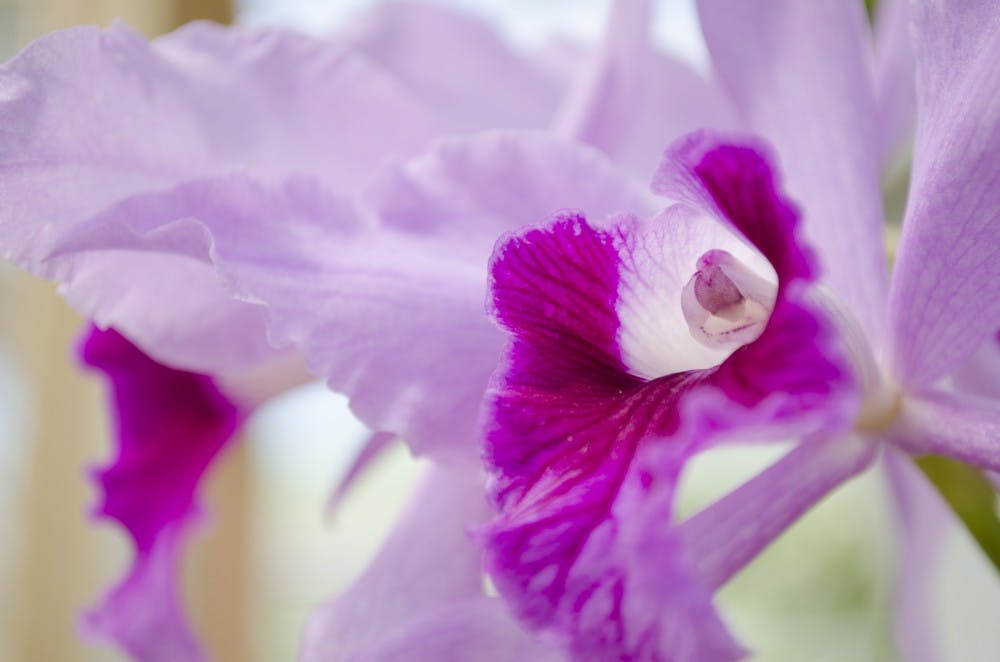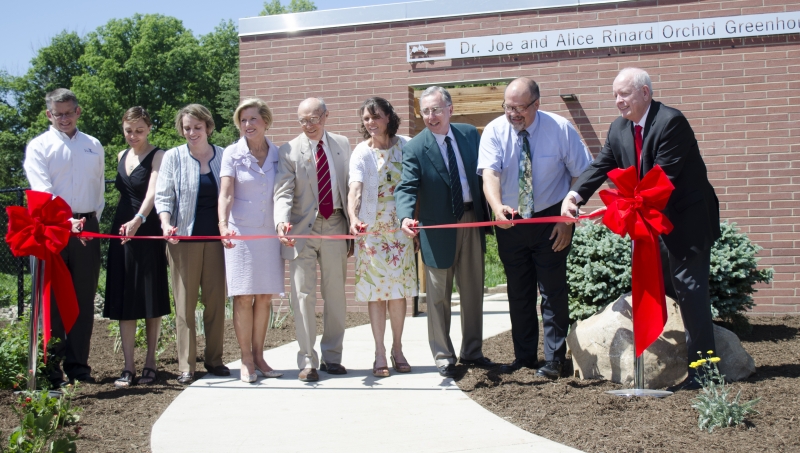Dr. Joe and Alice Rinard Orchid Greenhouse in Christy Woods
The $1.35 million, 3,600-square-foot facility will house Wheeler-Thanhauser Collection.
By the end of the summer, it will have about 1,800 orchids, some endangered or from tropical regions.
There are approximately 25,000 to 30,000 species of orchids in the world.
The visitors paced themselves through Ball State’s new greenhouse Saturday, examining the vibrant variety of orchids. However, some people took the time to congratulate an emotional Cheryl LeBlanc, the greenhouse’s curator.
“I’m just proud to have [the orchids] in a better home,” LeBlanc said. “It’s been such an amazing turnout.”
Alex Salmins, an alumnus and a former three-year greenhouse employee, stepped away from the tour to give LeBlanc a quick hug. He came from Indianapolis for the opening.
“My favorite part of my job was spending time with Cheryl,” he said. “I liked hearing her passion. [The greenhouse] is something special.”
LeBlanc has worked since March, when the greenhouse was handed over to Ball State, to have the facility ready for its opening. More than 300 people volunteered to help her.
After 20 years of working with the collection, she will now work full time in the greenhouse.
The new $1.35 million Dr. Joe and Alice Rinard Orchid Greenhouse in Christy Woods will replace the old one as home to the Wheeler-Thanhauser Collection, the country’s largest collegiate collection of orchids.
The new facility was dedicated to the Rinards. Alice Rinard was a Ball State alumna who received her master’s in speech and audiology in 1963 and had a love of flowers. She died from metastatic breast cancer in 2010. Joe Rinard is a Ball State alumnus and a retired dentist.
“Ball State called me up and told me the story and what they wanted to do,” he said. “And I said, ‘Why not?’”
The 3,600-square-foot facility will house the entire orchid collection of about 1,800 by the end of the summer. Some orchids in the collection are endangered or from tropical regions. There are approximately 25,000 to 30,000 species of orchids. Indiana is home to 43 native species of orchids — Hawaii is home to three.
Many of the bloomed flowers on display for the opening ceremony were on loan from places around Indiana. Only a third of the Wheeler-Thanhauser Collection was on display.
The new greenhouse is phase one of the entire project. Phase two will include a teaching collection, a classroom and space for research. Currently, the old greenhouse will be used for this purpose until phase two has the funding.
In 1971, the university founded the collection, housed in the old orchid greenhouse. A project to create a new one began in the 1980s, but it was shelved.
When President Jo Ann Gora was applying for the job as university president, she said she picked up a book on Indiana. The only thing mentioned about East Central Indiana was the orchid collection.
“When I came here, I saw there was so much more and I resolved to change that,” she said. “Wheeler was poorly constructed and that needed to change.”
LeBlanc said one of the big problems with the old greenhouse was the climate control wasn’t reliable, and it could hurt the plants.
The new space will allow for enhanced education on ecology and the environment because it is a “living botanical laboratory,” said Michael Maggiotto, dean of the College of Sciences and Humanities.
“The new greenhouse will allow us teach about how a species adapted so well to ecological diversity,” Maggiotto said.
However, the educational value is varied.
The new greenhouse will double as a display for the art of students and community members.
“Expect creative students, such as writers and artists, to come here in greater numbers now with this new space,” Maggiotto said.
Already at its opening, art students and community members have contributed a variety of pieces. A tree made out of cork acts as a planter and hanging from the ceiling are tapestries with painted exotic and tropical butterflies and a large metal cicada.
LeBlanc pointed to a vanilla orchid.
“We will be able to teach where our food comes from,” she said.
LeBlanc held up a jar of vanilla orchid roots, which provides vanilla extract.
“It’s more than a place for pretty flowers,” she said.
View a photo gallery of the opening.






